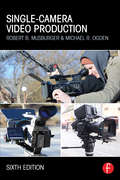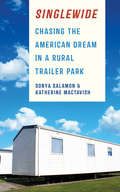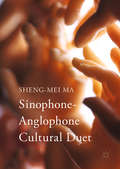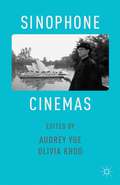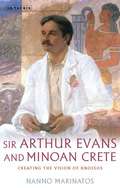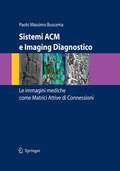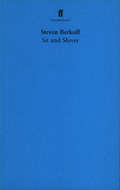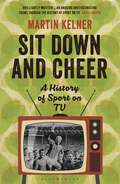- Table View
- List View
Single-Camera Video Production
by Robert B. Musburger Michael R OgdenLearn everything you need to know about creating video using the single-camera format, from preproduction planning to setting up, rehearsing, shooting, striking, and pleasing your audience. Harness lighting, audio, editing, and aesthetic techniques that will enhance the quality of your video projects and keep your clients coming back for more. Simple, elegant, and easy to use, Single-Camera Video Production, Sixth Edition is a staple in any video artist’s library. Whether you’re just learning the basics of video production or you’re a veteran who needs a refresher, this book provides you with a toolkit for understanding and implementing single-camera workflows, as well as how to use the single-camera format to its best advantage by emphasizing the importance of goals, audience analysis, and technology. This new edition has been updated to include: Expanded sections on digital workflows, field and studio production, preproduction planning, audio, lighting, distribution, and nonlinear editing techniques Detailed gear lists covering the latest camera, recorder, audio, lighting, and stabilization equipment used in the industry today Fresh tips on creating video for your target audience and exhibition platform and shooting for the editing process Insider career advice, including tips on how to get an internship, interviewing, finding a job, and earning a promotion A companion website (www.focalpress.com/cw/musburger) with video examples of the techniques discussed in the book as well as evolving updates on key technological shifts
Single-Camera Video Production (Media Manuals Ser.)
by Robert B. Musburger Michael R OgdenLearn everything you need to know about creating video using the single-camera format, from preproduction planning to setting up, rehearsing, shooting, striking, and pleasing your audience. Harness lighting, audio, editing, and aesthetic techniques that will enhance the quality of your video projects and keep your clients coming back for more. Simple, elegant, and easy to use, Single-Camera Video Production, Sixth Edition is a staple in any video artist’s library. Whether you’re just learning the basics of video production or you’re a veteran who needs a refresher, this book provides you with a toolkit for understanding and implementing single-camera workflows, as well as how to use the single-camera format to its best advantage by emphasizing the importance of goals, audience analysis, and technology. This new edition has been updated to include: Expanded sections on digital workflows, field and studio production, preproduction planning, audio, lighting, distribution, and nonlinear editing techniques Detailed gear lists covering the latest camera, recorder, audio, lighting, and stabilization equipment used in the industry today Fresh tips on creating video for your target audience and exhibition platform and shooting for the editing process Insider career advice, including tips on how to get an internship, interviewing, finding a job, and earning a promotion A companion website (www.focalpress.com/cw/musburger) with video examples of the techniques discussed in the book as well as evolving updates on key technological shifts
A single lens reflex (large print)
by RnibThis is a cross section side view of a single lens reflex camera seen from the side with a labelled enlargement of the mirror, and a key. There is a locator dot shown, which will be at the top left of the page when the image is the correct way up. The camera can be found in the bottom left of the page. A ray of light enters the camera through the lenses at the right of the image. It is represented by a left-pointing arrow. The ray then strikes the mirror to the left, which is angled at 45 degrees. The ray is then reflected through 90 degrees up the page to the pentaprism (five-sided prism), where it is reflected off two of the internal surfaces and exits left through the viewfinder lens at the top left of the image. To the left of the viewfinder is an eye seen from the side and facing to the right. The ray enters the eye and projects an image on the retina (not shown) on the left of the eye. Part of the mirror in the centre of the camera's image is circled with a dashed line with a line going up and right to another dashed-line circle containing an enlarged view of the mirror section. The light ray is shown being reflected off the surface of the mirror. The angles of incidence and reflection are labelled with abbreviations, and there is a key to the abbreviations in the top left of the page.
A single lens reflex (UEB contracted)
by RnibThis is a cross section side view of a single lens reflex camera seen from the side with a labelled enlargement of the mirror, and a key. There is a locator dot shown, which will be at the top left of the page when the image is the correct way up. The camera can be found in the bottom left of the page. A ray of light enters the camera through the lenses at the right of the image. It is represented by a left-pointing arrow. The ray then strikes the mirror to the left, which is angled at 45 degrees. The ray is then reflected through 90 degrees up the page to the pentaprism (five-sided prism), where it is reflected off two of the internal surfaces and exits left through the viewfinder lens at the top left of the image. To the left of the viewfinder is an eye seen from the side and facing to the right. The ray enters the eye and projects an image on the retina (not shown) on the left of the eye. Part of the mirror in the centre of the camera's image is circled with a dashed line with a line going up and right to another dashed-line circle containing an enlarged view of the mirror section. The light ray is shown being reflected off the surface of the mirror. The angles of incidence and reflection are labelled with abbreviations, and there is a key to the abbreviations in the top left of the page.
A single lens reflex (UEB uncontracted)
by RnibThis is a cross section side view of a single lens reflex camera seen from the side with a labelled enlargement of the mirror, and a key. There is a locator dot shown, which will be at the top left of the page when the image is the correct way up. The camera can be found in the bottom left of the page. A ray of light enters the camera through the lenses at the right of the image. It is represented by a left-pointing arrow. The ray then strikes the mirror to the left, which is angled at 45 degrees. The ray is then reflected through 90 degrees up the page to the pentaprism (five-sided prism), where it is reflected off two of the internal surfaces and exits left through the viewfinder lens at the top left of the image. To the left of the viewfinder is an eye seen from the side and facing to the right. The ray enters the eye and projects an image on the retina (not shown) on the left of the eye. Part of the mirror in the centre of the camera's image is circled with a dashed line with a line going up and right to another dashed-line circle containing an enlarged view of the mirror section. The light ray is shown being reflected off the surface of the mirror. The angles of incidence and reflection are labelled with abbreviations, and there is a key to the abbreviations in the top left of the page.
Single People and Mass Housing in Germany, 1850–1930: (No)Home Away from Home (Visual Cultures and German Contexts)
by Erin Eckhold SassinUnsettling traditional understandings of housing reform as focused on the nuclear family with dependent children, Single People and Mass Housing in Germany, 1850-1930 is the first complete study of single-person mass housing in Germany and the pivotal role this class- and gender-specific building type played for over 80 years-in German architectural culture and society, the transnational Progressive reform movement, Feminist discourse, and International Modernism-and its continued relevance.Homes for unmarried men and women, or Ledigenheime, were built for nearly every powerful interest group in Germany-progressive, reactionary, and radical alike-from the mid-nineteenth century into the 1920s. Designed by both unknown craftsmen and renowned architects ranging from Peter Behrens to Bruno Taut, these homes fought unregimented lodging in overcrowded working-class dwellings while functioning as apparatuses of moral and social control. A means to societal reintegration, Ledigenheime effectively bridged the public-private divide and rewrote the rules of who was deserving of quality housing-pointing forward to the building programs of Weimar Berlin and Red Vienna, experimental housing in Soviet Russia, Feminist collectives, accommodations for postwar “guestworkers,” and even housing for the elderly today.
Single People and Mass Housing in Germany, 1850–1930: (No)Home Away from Home (Visual Cultures and German Contexts)
by Erin Eckhold SassinUnsettling traditional understandings of housing reform as focused on the nuclear family with dependent children, Single People and Mass Housing in Germany, 1850-1930 is the first complete study of single-person mass housing in Germany and the pivotal role this class- and gender-specific building type played for over 80 years-in German architectural culture and society, the transnational Progressive reform movement, Feminist discourse, and International Modernism-and its continued relevance.Homes for unmarried men and women, or Ledigenheime, were built for nearly every powerful interest group in Germany-progressive, reactionary, and radical alike-from the mid-nineteenth century into the 1920s. Designed by both unknown craftsmen and renowned architects ranging from Peter Behrens to Bruno Taut, these homes fought unregimented lodging in overcrowded working-class dwellings while functioning as apparatuses of moral and social control. A means to societal reintegration, Ledigenheime effectively bridged the public-private divide and rewrote the rules of who was deserving of quality housing-pointing forward to the building programs of Weimar Berlin and Red Vienna, experimental housing in Soviet Russia, Feminist collectives, accommodations for postwar “guestworkers,” and even housing for the elderly today.
Single-Shot 3D Sensing Close to Physical Limits and Information Limits (Springer Theses)
by Florian WillomitzerThis thesis discusses the physical and information theoretical limits of optical 3D metrology, and, based on these principal considerations, introduces a novel single-shot 3D video camera that works close to these limits. There are serious obstacles for a “perfect” 3D-camera: The author explains that it is impossible to achieve a data density better than one third of the available video pixels. Available single-shot 3D cameras yet display much lower data density, because there is one more obstacle: The object surface must be “encoded” in a non-ambiguous way, commonly by projecting sophisticated patterns. However, encoding devours space-bandwidth and reduces the output data density. The dissertation explains how this profound dilemma of 3D metrology can be solved, exploiting just two synchronized video cameras and a static projection pattern.The introduced single-shot 3D video camera, designed for macroscopic live scenes, displays an unprecedented quality and density of the 3D point cloud. The lateral resolution and depth precision are limited only by physics. Like a hologram, each movie-frame encompasses the full 3D information about the object surface and the observation perspective can be varied while watching the 3D movie.
Singlewide: Chasing the American Dream in a Rural Trailer Park
by Sonya Salamon Katherine MacTavishIn Singlewide, Sonya Salamon and Katherine MacTavish explore the role of the trailer park as a source of affordable housing. America’s trailer parks, most in rural places, shelter an estimated 12 million people, and the authors show how these parks serve as a private solution to a pressing public need. Singlewide considers the circumstances of families with school-age children in trailer parks serving whites in Illinois, Hispanics in New Mexico, and African Americans in North Carolina. By looking carefully at the daily lives of families who live side by side in rows of manufactured homes, Salamon and MacTavish draw conclusions about the importance of housing, community, and location in the families’ dreams of opportunities and success as signified by eventually owning land and a conventional home. Working-poor rural families who engage with what Salamon and MacTavish call the "mobile home industrial complex" may become caught in an expensive trap starting with their purchase of a mobile home. A family that must site its trailer in a land-lease trailer park struggles to realize any of the anticipated benefits of homeownership. Seeking to break down stereotypes, Salamon and MacTavish reveal the important place that trailer parks hold within the United States national experience. In so doing, they attempt to integrate and normalize a way of life that many see as outside the mainstream, suggesting that families who live in trailer parks, rather than being "trailer trash," culturally resemble the parks’ neighbors who live in conventional homes.
Singular Plural Ways of Staging Together: Perspectives on Contemporary Dance, Art Performance and Visual Art (TanzScripte #72)
by Iris JulianFocusing on staging processes in contemporary dance and art performance creates new opportunities to study creative participation and co-authorship. To gain these new insights, Iris Julian analyses experimental projects initiated by two groups and a single choreographer: Collect-if by Collect-if, Deufert + Plischke and Xavier Le Roy. By exploring nuances of staging work, the concept of singular plural became the analytical guideline and resulted into three research perspectives: theatre studies, sociology and ontological reading (Jean-Luc Nancy, Michaela Ott, Gerald Raunig). This approach makes it possible to look beyond the importance that is often credited to single authorship in the arts. With a foreword by Prof. Dr. Gerald Siegmund.
Singularities: Dance in the Age of Performance
by Andre LepeckiHow does the production of performance engage with the fundamental issues of our advanced neo-capitalist age? André Lepecki surveys a decade of experimental choreography to uncover the dual meaning of ‘performance’ in the twenty-first century: not just an aesthetic category, but a mode of political power. He demonstrates the enduring ability of performance to critique and subvert this power, examining this relationship through five ‘singularities’ in contemporary dance: thingness, animality, persistence, darkness, and solidity. Exploring the works of Mette Ingvartsen, Yvonne Rainer, Ralph Lemon, Jérôme Bel and others, Lepecki uses his concept of ‘singularity’—the resistance of categorization and aesthetic identification—to examine the function of dance and performance in political and artistic debate.
Singularities: Dance in the Age of Performance
by Andre LepeckiHow does the production of performance engage with the fundamental issues of our advanced neo-capitalist age? André Lepecki surveys a decade of experimental choreography to uncover the dual meaning of ‘performance’ in the twenty-first century: not just an aesthetic category, but a mode of political power. He demonstrates the enduring ability of performance to critique and subvert this power, examining this relationship through five ‘singularities’ in contemporary dance: thingness, animality, persistence, darkness, and solidity. Exploring the works of Mette Ingvartsen, Yvonne Rainer, Ralph Lemon, Jérôme Bel and others, Lepecki uses his concept of ‘singularity’—the resistance of categorization and aesthetic identification—to examine the function of dance and performance in political and artistic debate.
Sinn und Sinne im Tanz: Perspektiven aus Kunst und Wissenschaft. Jahrbuch TanzForschung 2020 (TanzForschung #30)
by Margrit Bischof Friederike LampertÄhnlich und doch verschieden: Sinn und Sinne im Tanz. Sinn steht für Sinnhaftes, für Einsicht und Vernunft - und mit Sinne wird alles Sinnliche, wird Erfahrung und Wahrnehmung verbunden. Tanz macht Sinn, Tanz ist Sinnlichkeit. Aus der Reibung dieser beiden Pole entstehen für den künstlerischen Tanz wie auch für deren Erforschung neuartige Ansätze. Das im Körper gespeicherte Wissen spielt dabei eine bedeutende Rolle. Aus der Perspektive unterschiedlicher Autor*innen aus Kunst und Wissenschaft werden Wege aufgezeigt, wie aus verschiedenen Situationen neuartige Zugänge zu künstlerischer, forschender und vermittelnder Praxis entspringen können. Dieses gtf-Jahrbuch entstand in Zusammenarbeit mit dem Institute for the Performing Arts and Film (IPF) der Zürcher Hochschule der Künste und erscheint als Band 20 der Reihe subTexte.
Sinophone Adaptations of Shakespeare: An Anthology, 1987-2007 (Global Shakespeares)
by Alexa Alice JoubinShakespeare’s tragedies have been performed in the Sinophone world for over two centuries. Hamlet, Macbeth, and King Lear are three of the most frequently adapted plays. They have been re-imagined as political theatre, comedic parody, Chinese opera, avant-garde theatre, and experimental theatre in Hong Kong, China, and Taiwan. This ground-breaking anthology features the first English translations of seven influential adaptations from 1987 to 2007 across a number of traditional and modern performance genres in Beijing, Shanghai, Hong Kong, and Taipei. Each of the book's three sections offers a pair of two contrasting versions of each tragedy - in two distinct genres - for comparative analysis. This anthology is an indispensable tool for the teaching and research of Sinophone theatre's engagement with Western classics in the late twentieth and early twenty-first centuries.
Sinophone-Anglophone Cultural Duet
by Sheng-Mei MaThis book examines the paradox of China and the United States’ literary and visual relationships, morphing between a happy duet and a contentious duel in fiction, film, poetry, comics, and opera from both sides of the Pacific. In the 21st century where tension between the two superpowers escalates, a gaping lacuna lies in the cultural sphere of Sino-Anglo comparative cultures. By focusing on a “Sinophone-Anglophone” relationship rather than a “China-US” one, Sheng-mei Ma eschews realpolitik, focusing on the two languages and the cross-cultural spheres where, contrary to Kipling’s twain, East and West forever meet, like a repetition compulsion bordering on neurosis over the self and its cultural other. Indeed, the coupling of the two—duet-cum-duel—is so predictable that each seems attracted to and repulsed by its dark half, semblable, (in)compatible for their shared larger-than-life-ness.
Sinophone-Anglophone Cultural Duet
by Sheng-Mei MaThis book examines the paradox of China and the United States’ literary and visual relationships, morphing between a happy duet and a contentious duel in fiction, film, poetry, comics, and opera from both sides of the Pacific. In the 21st century where tension between the two superpowers escalates, a gaping lacuna lies in the cultural sphere of Sino-Anglo comparative cultures. By focusing on a “Sinophone-Anglophone” relationship rather than a “China-US” one, Sheng-mei Ma eschews realpolitik, focusing on the two languages and the cross-cultural spheres where, contrary to Kipling’s twain, East and West forever meet, like a repetition compulsion bordering on neurosis over the self and its cultural other. Indeed, the coupling of the two—duet-cum-duel—is so predictable that each seems attracted to and repulsed by its dark half, semblable, (in)compatible for their shared larger-than-life-ness.
Sinophone Cinemas
by Audrey YueSinophone Cinemas considers a range of multilingual, multidialect and multi-accented cinemas produced in Chinese-language locations outside mainland China. It showcases new screen cultures from Britain, Hong Kong, Taiwan, Singapore and Australia.
Sir Arthur Evans and Minoan Crete: Creating the Vision of Knossos (Library of Classical Studies)
by Nanno MarinatosBefore Sir Arthur Evans, the principal object of Greek prehistoric archaeology was the reconstruction of history in relation to myth. European travellers to Greece viewed its picturesque ruins as the gateway to mythical times, while Heinrich Schliemann, at the end of the nineteenth century, allegedly uncovered at Troy and Mycenae the legendary cities of the Homeric epics. It was Evans who, in his controversial excavations at Knossos, steered Aegean archaeology away from Homer towards the broader Mediterranean world. Yet in so doing he is thought to have done his own inventing, recreating the Cretan Labyrinth via the Bronze Age myth of the Minotaur. Nanno Marinatos challenges the entrenched idea that Evans was nothing more than a flamboyant researcher who turned speculation into history. She argues that Evans was a proper archaeologist who used scientific observation and classification. Evans' combination of anthropology, comparative religion and analysis of cultic artefacts enabled him to develop a bold new method which the author calls 'mental anthropology'. This method enabled him to develop remarkable ideas about Minoan religion that are now being vindicated as startling new evidence comes to light.
Sir Christopher Wren (Shire Library)
by Paul RabbittsSir Christopher Wren (1632–1723) is now mostly remembered as a genius of architecture – but he was also an accomplished polymath, who only came to architecture quite late in life. Most famous as the mastermind behind the rebuilding of St Paul's Cathedral and more than fifty parish churches after the Great Fire of London, among his countless other projects Wren also designed the Royal Hospital at Chelsea, the Royal Naval Hospital at Greenwich, and much of Hampton Court Palace. Replete with colourful images of his buildings, this concise biography tells the story of a man whose creations are still popular tourist attractions to this day, but also casts light on Wren's credentials as an intellectual and a founding member of the Royal Society.
Sir Christopher Wren (Shire Library)
by Paul RabbittsSir Christopher Wren (1632–1723) is now mostly remembered as a genius of architecture – but he was also an accomplished polymath, who only came to architecture quite late in life. Most famous as the mastermind behind the rebuilding of St Paul's Cathedral and more than fifty parish churches after the Great Fire of London, among his countless other projects Wren also designed the Royal Hospital at Chelsea, the Royal Naval Hospital at Greenwich, and much of Hampton Court Palace. Replete with colourful images of his buildings, this concise biography tells the story of a man whose creations are still popular tourist attractions to this day, but also casts light on Wren's credentials as an intellectual and a founding member of the Royal Society.
Sirk on Sirk (Directors On Directors Ser.)
by Jon HallidayDouglas Sirk is one of the most neglected directors in American cinema. This book aims to rectify that and, through a survey of his career, to re-establish Sirk as one of the great stylists of Hollywood cinema.In 1937 Sirk left Germany, after a successful career in theatre and film, and came to Hollywood. From 1942 to 1958 he directed some 30 films, the most famous of which were a series of lush melodramas in the '50s, which were seen at the time as vehicles for stars such as Rock Hudson and Lana Turner. These films are now seen as perceptive dissections of the repressive conventions underlying American life, revealing a disintegrating society - a society of pretence and illusion, befogged by alcohol. Sirk's films are many-layered, the style transcending the melodrama and transforming the material into works of art.
Sistemi ACM e Imaging Diagnostico: Le immagini mediche come Matrici Attive di Connessioni
by Paolo Massimo BuscemaLa prima ipotesi sulla quale si fondano i sistemi ACM (Active Connections Matrix) è che ogni immagine a N dimensioni puo' essere trasformata in una rete di pixel tra loro connessi che si sviluppa nel tempo, tramite operazioni locali, deterministiche e iterative. L'immagine cosi' trasformata puo' mostrare, in uno spazio dimensionale più ampio, delle regolarità morfologiche e dinamiche che, nelle dimensioni originarie, sarebbero non visibili oppure qualificabili come rumore.Questa ipotesi permette di esplicitare la seconda ipotesi alla base dei sistemi ACM: ogni immagine contiene al suo interno le matematiche inerenti che l'hanno prodotta. In pratica, è come se ogni immagine nascondesse al suo interno altre due immagini non visibili. I sistemi ACM le estraggono e le rendeno visibili. L'opera descrive inoltre le applicazioni possibili in ambito di diagnostica per immagini ed è pertanto rivolta a fisici, informatici, radiologi e tecnici di laboratorio che si occupano di "image processing". Dalla Presentazione di Enzo Grossi "... Alcuni dettagli possono sfuggire, altri aspetti notevoli, come un piccolo nodulo di 1 mm, possono essere non visti: sono i limiti dell'occhio umano. E' in questo scenario che dobbiamo immaginare l'avvento dei sistemi ACM.Essi funzionano come un terzo occhio, non più legato alla esperienza, alla interpretazione e alla sensibilità soggettiva dell'operatore,ma direttamente riferiti alla struttura matematica e quindi anatomica dell'immagine stessa. Si', il terzo occhio di cui parliamo è proprio quello dell'immagine, che, come per magia, interroga se stessa e si mostra al radiologo sotto una veste diversa, spesso molto più informativa."
The Sistine Chapel: History of a Masterpiece
by Antonio ForcellinoThe Sistine Chapel is one of the world&’s most magnificent buildings, and the frescos that decorate its ceiling and walls are a testimony to the creative genius of the Renaissance. Two generations of artists worked at the heart of Christianity, over the course of several decades in the fifteenth and sixteenth centuries, to produce this extraordinary achievement of Western civilization. In this book, the art historian and restorer Antonio Forcellino tells the remarkable story of the Sistine Chapel, bringing his unique combination of knowledge and skills to bear on the conditions that led to its creation. Forcellino shows that Pope Sixtus IV embarked on the project as an attempt to assert papal legitimacy in response to Mehmed II&’s challenge to the Pope&’s spiritual leadership. The lower part of the chapel was decorated by a consortium of master painters whose frescoes, so coherent that they seem almost to have been painted by a single hand, represent the highest expression of the Quattrocento Tuscan workshops. Then, in 1505, Sixtus IV&’s nephew, Julius II, imposed a change in direction. Having been captivated by the prodigious talent of a young Florentine sculptor, Julius II summoned Michelangelo Buonarroti to Rome and commissioned him to paint the ceiling of the Sistine Chapel. Two decades later, Michelangelo returned to paint The Last Judgement, which covers the wall behind the alter. Michelangelo&’s revolutionary work departed radically from tradition and marked a turning point in the history of Western art. Antonio Forcellino brings to life the wonders of the Sistine Chapel by describing the aims and everyday practices of the protagonists who envisioned it and the artists who created it, reconstructing the material history that underlies this masterpiece.
Sit and Shiver
by Steven BerkoffHow a certain Jewish family mourns a dead patriarch. The term is 'sitting Shiva' (mourning for seven days), when friends and relatives commiserate, usually in the home of the deceased. As children, we always understood this to be 'sit and shiver', which also seemed most appropriate. While death has claimed the old man and triggered the usual inflated eulogies - 'how important a man becomes when they die' - it has also brought to the surface hidden anxieties and grievances, only exacerbated when a visitor shows up bearing strange news that threatens to tear the family apart.A Jewish black comedy in the Berkoff tradition.Sit and Shiver was first presented at the Odyssey Theater, Los Angeles, in March 2004. The European premiere was held at the New End Theatre, London, in association with Saw Productions, in May 2006.
Sit Down and Cheer: A History of Sport on TV (Wisden Sports Writing)
by Martin KelnerTelevision and sport is the ultimate marriage of convenience. The two circled each other warily for a while - sport anxious the sofa-bound might spurn the live product, TV reluctant in a limited channel world to hand over too much screen time to flannelled fools and muddied oafs. But they got together, and stayed together, for the sake of the money, and now you cannot imagine one without the other. They are indivisible, like an old couple sitting in a teashop finishing each other's sentences, and there is little doubt which is the dominant partner. You have only to think of the recent sports stars who have left their muddy fields to don sequins, grab partners and tango their way across the stage in ultimate Saturday night television style, to see how far the two have come on their journey together.In Sit Down and Cheer Martin Kelner traces the development of this relationship from its humble origins in the 1960 Olympics, by way of the first-ever Match of the Day in 1964, through to the financial impact of Sky, right up to the high-tech gadgetry of our present-day viewing. Insightful and very funny, this is an entertaining exploration of two major national pastimes and not to be missed.
